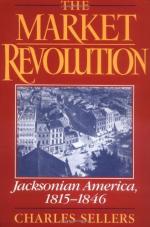
|
| Name: _________________________ | Period: ___________________ |
This test consists of 15 multiple choice questions and 5 short answer questions.
Multiple Choice Questions
1. To what does Sellers attribute the rise in democratic sentiment?
(a) The people's desire for stability.
(b) The people's desire for cheaper goods.
(c) The people's desire for peace.
(d) The people's desire for western expansion.
2. What factory work does Sellers say became much more efficient in Jackson's America?
(a) Cotton processing.
(b) Paper processing.
(c) Railroad manufacturing.
(d) Gun production.
3. How does Sellers say the Republican pro-market forces counteracted anti-market forces?
(a) By buying or suppressing their votes.
(b) By getting them to support Republicans.
(c) By rigging elections against their candidates.
(d) By making compromises with them.
4. What was DeWitt Clinton's role in the Republican party?
(a) Opposition candidate.
(b) Populist leader.
(c) Party kingmaker.
(d) Standard-bearer.
5. What does Sellers say would be the result of expanding markets?
(a) Proletarian uprisings.
(b) Distribution of wealth.
(c) Concentration of wealth.
(d) Restricting the creation of wealth.
6. What led to the expansion of trade routes, according to Sellers?
(a) Larger markets.
(b) Fewer pirates.
(c) Improved ships.
(d) Faster production times.
7. What does Sellers say the Northern interests pushed for?
(a) The Brooklyn Bridge.
(b) Dredging the Mississippi.
(c) Charting the Louisiana Purchase.
(d) The Erie Canal.
8. How does Sellers describe the Republicanism of Thomas Jefferson and James Madison?
(a) Extreme.
(b) Literate.
(c) Committed.
(d) Ambiguous.
9. Who will suffer with expanding markets?
(a) Investors.
(b) Manufacturers.
(c) Politicians.
(d) Landowners.
10. How does Sellers say Americans reproduced in Jackson's America?
(a) Quickly.
(b) Steadily.
(c) Slowly.
(d) Deliberately.
11. In what case was expansionism restrained?
(a) Into Mexico.
(b) Into Florida.
(c) Into Canada.
(d) Native Americans.
12. What did the First Bank of the United States do to the economy?
(a) Increase the amount of currency.
(b) Tighten credit.
(c) Devalue currency.
(d) Regulate markets.
13. Who succeeded James Monroe in the White House?
(a) Henry Clay.
(b) James Madison.
(c) John Quincy Adams.
(d) Andrew Jackson.
14. What happened to Jackson during the panic of 1819?
(a) He bought a larger house.
(b) His family lost their estate.
(c) He lost a lot of money.
(d) He made a lot of money.
15. Who did the public feel hostility toward, according to Sellers?
(a) Foreigners.
(b) Slaves.
(c) Immigrants.
(d) Elites.
Short Answer Questions
1. How were people feeling about slavery in the 1810s?
2. How did liberal Democrats view Republican use of paper currency?
3. What sphere did NOT change under Jackson, according to Sellers?
4. Who felt threatened by the market revolution, according to Sellers?
5. When does Sellers date the beginning of the Jacksonian era?
|
This section contains 447 words (approx. 2 pages at 300 words per page) |

|




